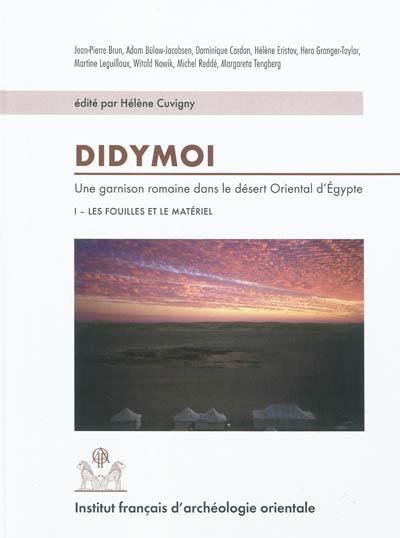
Fiche technique
Format : Relié
Nb de pages : XXV-409 pages
Poids : 2288 g
Dimensions : 25cm X 33cm
ISBN : 978-2-7247-0582-9
EAN : 9782724705829
Les fouilles et le matériel
Quatrième de couverture
Didymoi - la Didyme de l'Itinéraire Antonin - fait partie de la douzaine de fortins (praesidia) construits par les Romains pour contrôler la route caravanïère de Koptos, sur le Nil, à Béré-nice, sur la mer Rouge. Son nom se réfère à ses divinités tutélaires, les Dioscures, invoqués par ses occupants dans leurs lettres privées, même si le matériel issu de la chapelle montre que le dieu principal était, comme dans toute la région depuis Trajan, Zeus Hèlios Grand Sarapis. Trois saisons de fouilles, menées entre 1997 et 2000 et financées par le ministère des Affaires étrangères et l'Ifao, ont mis en évidence les temps forts de l'histoire de Didymoi : fondation en 76/77 à l'instigation du préfet lulius Ursus, renforcement des capacités de stockage d'eau sous Domitien, abandon probable dans le troisième quart du IIe siècle, effondrement du puits, reconstruit en 176/177, l'année qui suit le séjour de Marc-Aurèle à Alexandrie, Mais bientôt l'occupation du fortin change d'allure : à la place des anciens casernements, régulièrement nettoyés, prolifèrent des locaux minuscules où les ordures s'amoncellent. C'est l'époque où les nomades (barbaroi), qui collaborent désormais avec l'armée romaine, viennent se ravitailler en pain et en vin dans les praesidia. Didymoi est définitivement abandonné vers le milieu du IIIe siècle.
Dans ce premier volume sont présentés les résultats des fouilles et le matériel anépigraphe (à l'exception de la vaisselle céramique et des amphores), Didymoi s'est révélé un site exceptionnel pour les cuirs et pour les textiles. Les milliers de chiffons sortis des dépotoirs témoignent de la virtuosité des tisserands et des teinturiers égyptiens et de l'élégance vestimentaire des élites métropolitaines de la vallée du Nil ; ils révèlent en outre l'étonnante variété des produits textiles, de provenances très diverses, disponibles alors en Égypte.
Les inscriptions lapidaires et les ostraca grecs et latins sont publiés dans le second volume.
Didymoi - the Didyme of the Itinerarium Anto-ninianum - is one of the dozen fortlets (praesidia) that the Romans built to guard the caravan road from Coptos on the Nile to Bérénice on the Red Sea. The name dérives from its tutelary deities, the Dioscuri, who were invoked by the inhabitants in their private letters, although the finds from the chapel show that the pricipal god of the place, as in the whole région since the reign of Trajan, was Zeus Helios Great Sarapis, Three excavation campaigns between 1997 and 2000, campaigns that were financed by the French Ministry of Foreign Affairs and the Ifao, have brought to light the évidence for the important points of the history of Didymoi : the foundation in A.D. 76/77 ordered by the prefect lulius Ursus, the enlargement of the facilities for storing water under Domitian, the probable abandon in the third quarter of the second century, the foundering of the well and its reconstruction in A.D. 176/77, the year that followed Marcus Aurelius' visit to Alexandria. But soon after this the pattern of occupation changes : instead of the old barrack-rooms which were regularly cleaned, there are now a multitude of small rooms where rubbish abounds, This is the period when the nomads (barbaroi), who hence-forth collaborate with the Roman army, come to the praesidia to obtain bread and wine, Didymoi is definitively abandoned towards the middle of the third century.
This first volume contains the results of the excavations and the uninscribed finds with the exception of ceramic tableware and amphorae. Didymoi is a remarkable site for leather and textiles. The thousands of rags that hâve been brought to light from the rubbish dump show the virtuosity of the Egyptian weavers and dyers and the sartorial élégance of the upper classes in the towns of the Nile valley. Furthermore, they show the extraordinary variety of the textile products, often imported from far away, that were then available in Egypt.
The inscriptions and the ostraca in Greek and Latin are published in the second volume.





